The 2004 Toyota Sequoia, a robust and spacious SUV, arrived on the scene as a testament to Toyota’s commitment to crafting reliable and capable vehicles. This full-size SUV, designed to accommodate large families and adventurous souls, offered a compelling blend of comfort, performance, and practicality.
Its arrival marked a significant moment in the automotive market, as it aimed to capture the hearts of drivers seeking a vehicle that could handle both daily commutes and weekend escapades.
The 2004 Sequoia was built on a robust platform, boasting a powerful V8 engine and a spacious interior that could comfortably seat eight passengers. It was equipped with a range of standard and optional features, including a four-wheel drive system, advanced safety technologies, and a comfortable cabin designed for long journeys.
The Sequoia’s reputation for reliability and durability solidified its position as a popular choice for families and outdoor enthusiasts alike.
Overview: 2004 Toyota Sequoia

The 2004 Toyota Sequoia is a full-size SUV that was introduced in 2000 and remained in production until 2007. It was Toyota’s first full-size SUV and was designed to compete with other popular models like the Chevrolet Tahoe, Ford Expedition, and Dodge Durango.
The Sequoia was known for its spacious interior, powerful engine, and rugged capabilities.The 2004 model year saw a few updates and improvements over the previous years. The Sequoia was available in two trim levels: SR5 and Limited. Both trims came standard with a 4.7-liter V8 engine, a 4-speed automatic transmission, and four-wheel drive.
Key Features and Specifications
The 2004 Toyota Sequoia offered a range of features and specifications that catered to its target market.
- Engine:4.7-liter V8, producing 240 horsepower and 320 lb-ft of torque.
- Transmission:4-speed automatic transmission.
- Drivetrain:Four-wheel drive with a transfer case.
- Seating Capacity:Up to eight passengers.
- Cargo Space:18.9 cubic feet behind the third row, 66.6 cubic feet behind the second row, and 120.1 cubic feet with all seats folded down.
- Safety Features:Dual front airbags, side airbags, and curtain airbags.
Historical Context and Significance
The Toyota Sequoia’s introduction in 2000 marked a significant step for the Japanese automaker as it entered the full-size SUV segment, a market dominated by American manufacturers. The Sequoia was designed to appeal to families and outdoor enthusiasts who needed a vehicle with ample space, towing capacity, and off-road capabilities.
The Sequoia’s success helped Toyota establish itself as a major player in the SUV market, ultimately contributing to its growth and popularity in the United States.
Design and Styling
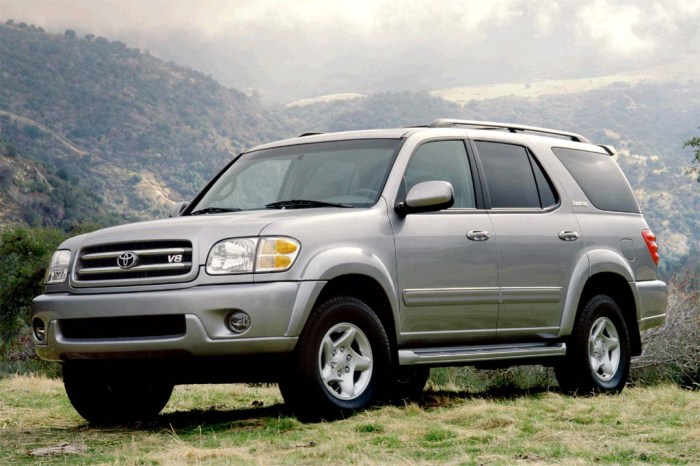
The 2004 Toyota Sequoia was a large SUV designed to offer a spacious and capable vehicle for families and adventurers alike. Its design reflected the robust and utilitarian nature of the vehicle, while still incorporating some stylistic elements to enhance its appeal.
Exterior Design
The exterior design of the 2004 Sequoia featured a boxy and rugged appearance, reflecting its off-road capabilities. Key design elements included a large, upright grille with the Toyota emblem prominently displayed, a high beltline, and a substantial overhang at the rear.
The design emphasized functionality, with large windows for visibility and a high roofline for ample headroom.
Interior Design
The interior of the 2004 Sequoia was designed with practicality and comfort in mind. It featured a spacious cabin that could accommodate up to eight passengers. The materials used were durable and functional, with cloth upholstery being standard and leather upholstery being available as an option.
The 2004 Toyota Sequoia, a full-size SUV, offered a robust and spacious design, catering to families and adventurers alike. While its focus was on practicality, Toyota had a history of creating innovative vehicles, like the 1991 Toyota Sera , a futuristic coupe with gullwing doors.
The Sequoia, however, was designed for a different purpose, prioritizing off-road capability and passenger comfort, making it a popular choice for those seeking a reliable and capable vehicle.
The dashboard was simple and straightforward, with easy-to-use controls. The seats were comfortable and supportive, offering ample legroom and headroom for all passengers.
Comparison to Competitors
In terms of design, the 2004 Sequoia was comparable to other large SUVs of the time, such as the Chevrolet Tahoe, Ford Expedition, and Nissan Armada. These competitors also featured a boxy and rugged design, emphasizing functionality and spaciousness. However, the Sequoia’s design was considered to be more refined and sophisticated, with its smooth lines and elegant styling.
Performance and Engine
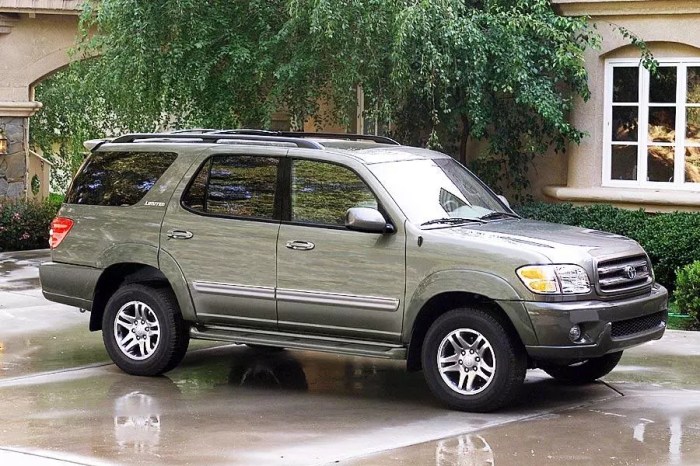
The 2004 Toyota Sequoia was available with two powerful engine options, catering to different needs and driving styles. These engines provided ample power for towing, hauling, and navigating challenging terrain.
The 2004 Toyota Sequoia is a full-size SUV that shares its platform with the Tundra pickup truck, known for its rugged durability and spacious interior. For those seeking a more luxurious and off-road capable option, the 2004 Toyota Land Cruiser might be a better fit.
While the Sequoia excels in towing and hauling capacity, the Land Cruiser offers superior off-road prowess and a more refined driving experience. Ultimately, the choice between these two Toyota giants depends on individual needs and preferences.
Engine Options and Performance
The 2004 Toyota Sequoia offered two engine choices:
- 4.7L V8:This engine produced 240 horsepower and 320 lb-ft of torque. It was the standard engine and offered adequate power for everyday driving and light towing. It achieved an estimated fuel economy of 14 mpg city and 18 mpg highway.
- 4.7L V8 (with i-Force):This engine, equipped with Toyota’s i-Force technology, delivered 270 horsepower and 341 lb-ft of torque. It offered increased power and towing capacity compared to the standard 4.7L V8, achieving an estimated fuel economy of 13 mpg city and 17 mpg highway.
Driving Experience
The 2004 Sequoia’s driving experience was generally comfortable and capable, thanks to its robust build and powerful engines. However, its large size and relatively high weight contributed to a less agile handling experience compared to some other SUVs in its class.
The Sequoia’s suspension provided a comfortable ride on paved roads, but it could feel somewhat harsh over rough terrain. The steering was generally responsive but lacked the precision found in some of its competitors.
The 2004 Toyota Sequoia was known for its strong towing capacity, making it a popular choice for families and individuals who frequently towed trailers or boats.
Safety Features

The 2004 Toyota Sequoia was designed with safety in mind, offering a comprehensive suite of standard and optional features to protect occupants in the event of an accident.
Standard Safety Features, 2004 Toyota Sequoia
The 2004 Sequoia came standard with a robust set of safety features, including:
- Anti-lock brakes (ABS)
- Electronic brake-force distribution (EBD)
- Dual front airbags
- Side airbags
- Side curtain airbags
- Child safety locks
- Three-point seatbelts for all seating positions
- Tire pressure monitoring system
- Daytime running lights
Optional Safety Features
While the standard safety features provided a solid foundation, Toyota offered additional safety features as optional equipment:
- Vehicle Stability Control (VSC)
- Traction Control (TRAC)
- Rear parking sensors
- Backup camera
Safety Ratings
At the time of its release, the 2004 Toyota Sequoia received the following safety ratings from the National Highway Traffic Safety Administration (NHTSA):
- Overall 5-star rating
- Front impact: 5 stars
- Side impact: 5 stars
- Rollover: 4 stars
The IIHS (Insurance Institute for Highway Safety) also awarded the 2004 Sequoia with a “Good” rating in its frontal offset crash test.
Comparison to Other SUVs
The 2004 Toyota Sequoia’s safety features were generally comparable to other SUVs in its class, such as the Chevrolet Tahoe, Ford Expedition, and Nissan Armada. These vehicles typically offered similar standard and optional safety features, including ABS, airbags, and electronic stability control.
However, the Sequoia’s strong safety ratings from NHTSA and IIHS highlighted its commitment to occupant protection.
Reliability and Maintenance
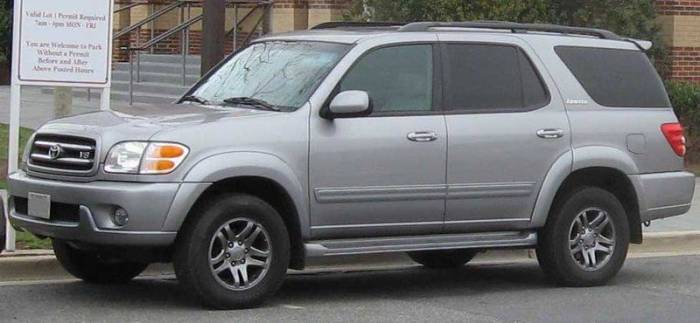
The 2004 Toyota Sequoia is known for its robust build and reliable performance, but like any vehicle, it requires proper maintenance to ensure longevity. This section explores the reliability of the 2004 Sequoia, common maintenance requirements, potential issues, and a comparison of its maintenance costs to other SUVs in its class.
Reliability
The 2004 Toyota Sequoia has a reputation for reliability, earning a good score from J.D. Power for its initial quality and a higher-than-average reliability rating from Consumer Reports. The Sequoia’s robust construction and proven powertrain contribute to its durable nature.
The 2004 Toyota Sequoia, a full-size SUV, offered a robust platform for families and adventurers alike. While known for its practicality and off-road capabilities, it’s interesting to note that Toyota’s history also includes a sporty and nimble model like the 1989 Toyota MR2 , a mid-engine sports car that captured the hearts of driving enthusiasts.
Returning to the Sequoia, its spacious interior and powerful engine made it a popular choice for those seeking a capable and comfortable vehicle.
However, like any vehicle, it’s crucial to adhere to a regular maintenance schedule to prevent potential issues.
Maintenance Requirements
The 2004 Toyota Sequoia requires regular maintenance to ensure optimal performance and extend its lifespan. The recommended maintenance schedule includes:
- Oil Changes:Every 3,000-5,000 miles or as recommended by the owner’s manual.
- Tire Rotation:Every 5,000-7,500 miles or as recommended by the owner’s manual.
- Air Filter Replacement:Every 12,000-15,000 miles or as recommended by the owner’s manual.
- Spark Plug Replacement:Every 60,000-100,000 miles depending on driving conditions and the type of spark plugs used.
- Transmission Fluid Flush:Every 60,000-100,000 miles depending on driving conditions.
- Brake Fluid Flush:Every 2-3 years or as recommended by the owner’s manual.
- Coolant Flush:Every 3-5 years or as recommended by the owner’s manual.
- Power Steering Fluid Flush:Every 50,000-75,000 miles depending on driving conditions.
Potential Issues
While the 2004 Toyota Sequoia is generally reliable, it’s not immune to potential issues. Some common issues reported by owners include:
- Transmission Problems:Transmission issues, including slipping or rough shifting, can occur due to worn-out parts or low transmission fluid levels.
- Engine Problems:Engine problems, such as misfires or rough idling, can be caused by worn-out spark plugs, faulty ignition coils, or fuel injector issues.
- Suspension Issues:Suspension problems, such as squeaking or clunking noises, can be caused by worn-out shock absorbers or struts.
- Electrical Issues:Electrical issues, such as malfunctioning lights or power windows, can be caused by faulty wiring or relays.
- Air Conditioning Issues:Air conditioning issues, such as a lack of cold air, can be caused by a refrigerant leak or a faulty compressor.
Maintenance Costs
The maintenance costs for a 2004 Toyota Sequoia are generally comparable to other SUVs in its class. However, costs can vary depending on factors such as driving habits, geographic location, and the specific maintenance needs of the vehicle.
- Routine Maintenance:Routine maintenance, such as oil changes, tire rotations, and air filter replacements, can cost between $50 and $100 per visit.
- Major Repairs:Major repairs, such as transmission replacements or engine overhauls, can cost several thousand dollars.
Tip:It’s essential to keep up with routine maintenance to prevent major repairs and ensure the longevity of your 2004 Toyota Sequoia.
Resale Value and Ownership Experience

The 2004 Toyota Sequoia, known for its robust build and reliable performance, holds its value reasonably well, especially when compared to some other SUVs in its class. However, its age and the availability of newer, more fuel-efficient models have impacted its resale value.
Resale Value
The average resale value of a 2004 Toyota Sequoia varies depending on factors such as mileage, condition, and trim level. According to Kelley Blue Book, the average trade-in value for a 2004 Sequoia in good condition with 100,000 miles is around $4,000 to $6,000.
This value can fluctuate depending on regional demand and market conditions.
Owner Experiences
The 2004 Sequoia has garnered a loyal following among owners who appreciate its ruggedness, spacious interior, and towing capacity. Here are some common themes that emerge from owner reviews:
Strengths
- Reliability:Toyota is renowned for its reliability, and the Sequoia is no exception. Owners often report minimal issues with the engine, transmission, and other components.
- Durability:The Sequoia’s robust construction and heavy-duty components make it capable of handling demanding conditions and off-road adventures.
- Spacious Interior:The Sequoia offers ample seating for up to eight passengers and plenty of cargo space. This makes it a practical choice for families or those who frequently transport passengers or cargo.
- Towing Capacity:With a maximum towing capacity of up to 7,400 pounds, the Sequoia is a capable tow vehicle for boats, trailers, and other heavy loads.
Weaknesses
- Fuel Efficiency:The Sequoia’s large size and powerful engine result in relatively poor fuel economy, especially compared to newer, more fuel-efficient SUVs.
- Ride Quality:The Sequoia’s solid build can translate into a somewhat stiff ride, particularly on rough roads.
- Interior Quality:While spacious, the interior materials may not be as luxurious or modern as those found in some newer SUVs.
Comparison to Other SUVs
When compared to other SUVs in its class, such as the Chevrolet Tahoe or Ford Expedition, the 2004 Sequoia holds up well in terms of reliability and durability. However, it falls behind in terms of fuel economy and interior refinement.
Newer SUVs in this class offer more advanced features, better fuel economy, and more sophisticated interior designs.
Comparison with Similar Vehicles
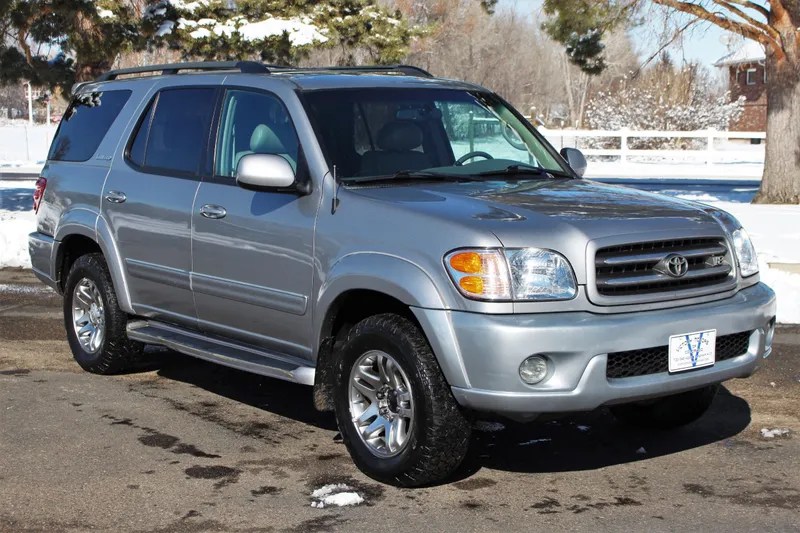
The 2004 Toyota Sequoia stands out as a capable and reliable full-size SUV, but it’s important to compare it to its direct competitors to understand its strengths and weaknesses. This section delves into a detailed comparison of the 2004 Sequoia with its rivals, including the Chevrolet Tahoe, Ford Expedition, and Nissan Armada, across key aspects like features, performance, safety, reliability, and resale value.
Comparison of Key Features
This section provides a side-by-side comparison of the 2004 Toyota Sequoia with its main competitors, highlighting their key features and specifications.
| Feature | 2004 Toyota Sequoia | 2004 Chevrolet Tahoe | 2004 Ford Expedition | 2004 Nissan Armada |
|---|---|---|---|---|
| Engine | 4.7L V8 (240 hp) | 5.3L V8 (290 hp) | 5.4L V8 (300 hp) | 5.6L V8 (305 hp) |
| Transmission | 4-speed automatic | 4-speed automatic | 4-speed automatic | 5-speed automatic |
| Seating Capacity | 8 | 9 | 8 | 8 |
| Cargo Space | 120.2 cubic feet | 108.9 cubic feet | 108.3 cubic feet | 103.3 cubic feet |
| Towing Capacity | 7,400 lbs | 8,500 lbs | 9,200 lbs | 9,100 lbs |
| Standard Features | Power windows, locks, and mirrors, CD player, cloth upholstery | Power windows, locks, and mirrors, CD player, cloth upholstery | Power windows, locks, and mirrors, CD player, cloth upholstery | Power windows, locks, and mirrors, CD player, cloth upholstery |
| Available Features | Leather upholstery, navigation system, sunroof, rear-seat entertainment system | Leather upholstery, navigation system, sunroof, rear-seat entertainment system | Leather upholstery, navigation system, sunroof, rear-seat entertainment system | Leather upholstery, navigation system, sunroof, rear-seat entertainment system |
Performance and Fuel Efficiency
The performance and fuel efficiency of the 2004 Toyota Sequoia are compared with its rivals.
| Vehicle | Engine | Horsepower | Torque | Fuel Economy (City/Highway/Combined) |
|---|---|---|---|---|
| 2004 Toyota Sequoia | 4.7L V8 | 240 hp | 320 lb-ft | 14/18/16 mpg |
| 2004 Chevrolet Tahoe | 5.3L V8 | 290 hp | 325 lb-ft | 14/19/16 mpg |
| 2004 Ford Expedition | 5.4L V8 | 300 hp | 355 lb-ft | 13/17/15 mpg |
| 2004 Nissan Armada | 5.6L V8 | 305 hp | 385 lb-ft | 13/18/15 mpg |
Safety Features
This section compares the safety features offered in the 2004 Toyota Sequoia with those available in its competing models.
- Standard Safety Features:All the vehicles in this comparison generally come standard with features like anti-lock brakes (ABS), traction control, and multiple airbags.
- Optional Safety Features:Some models might offer optional features like electronic stability control (ESC), side curtain airbags, and rear parking sensors.
Reliability and Maintenance
This section compares the reliability and maintenance costs of the 2004 Toyota Sequoia with its rivals.
- Reliability:Toyota has a strong reputation for reliability, and the 2004 Sequoia generally reflects that. However, all vehicles in this segment are known for their durability and can last for many years with proper maintenance.
- Maintenance Costs:Maintenance costs can vary depending on the specific model and driving habits. However, Toyota vehicles tend to have lower maintenance costs compared to some of their competitors.
Resale Value
This section compares the resale value of the 2004 Toyota Sequoia with its competitors.
- Resale Value:Toyota vehicles, in general, tend to hold their value better than some other brands. The 2004 Sequoia is expected to have a decent resale value compared to its competitors.
Conclusion
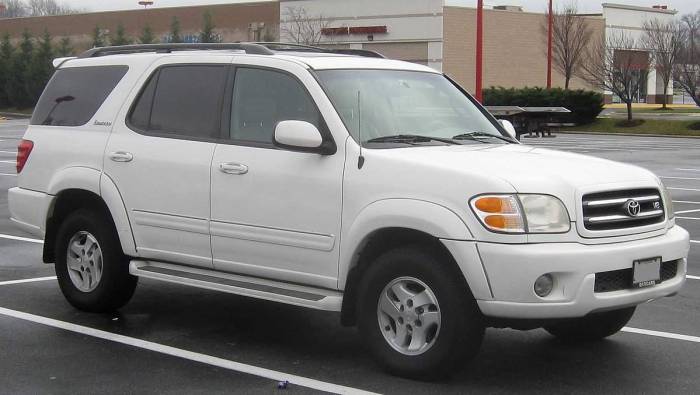
The 2004 Toyota Sequoia stands as a robust and capable SUV, offering a blend of spaciousness, off-road prowess, and Toyota’s renowned reliability. However, it’s essential to acknowledge its limitations, particularly in fuel efficiency and modern amenities.
Strengths and Weaknesses
The 2004 Sequoia excels in several areas, making it an attractive choice for specific buyers.
- Spacious Interior:The Sequoia boasts ample seating for up to eight passengers and generous cargo space, making it ideal for families or those who frequently transport passengers or cargo.
- Off-Road Capability:Its powerful engine and robust construction, combined with available four-wheel drive, provide impressive off-road capabilities, making it suitable for tackling challenging terrain.
- Reliability and Durability:Toyota’s reputation for reliability extends to the Sequoia, known for its robust build and long-lasting components, minimizing maintenance concerns and offering peace of mind.
However, the Sequoia also presents some drawbacks:
- Fuel Efficiency:Its large size and powerful engine result in relatively low fuel economy, making it an expensive vehicle to operate for daily commutes or long-distance driving.
- Outdated Technology:The 2004 model lacks modern features like touchscreen infotainment systems, advanced safety technologies, and driver assistance features found in newer vehicles.
- Ride Quality:The Sequoia’s body-on-frame construction can lead to a somewhat rough ride on uneven surfaces, particularly compared to more refined SUVs.
Suitability for Different Buyers
The 2004 Toyota Sequoia caters to a specific set of buyers who prioritize spaciousness, off-road capability, and reliability over fuel efficiency and modern amenities.
- Large Families:The Sequoia’s generous interior space makes it an excellent choice for families with multiple children or those who frequently transport passengers.
- Outdoor Enthusiasts:Its off-road capabilities make it suitable for adventurers who enjoy camping, hiking, or towing trailers.
- Those Seeking Reliability:Toyota’s reputation for reliability makes the Sequoia an attractive option for buyers who value dependability and minimize maintenance concerns.
However, the Sequoia might not be the ideal choice for:
- Budget-Conscious Buyers:Its low fuel economy and potential for higher maintenance costs make it an expensive vehicle to own and operate.
- Tech-Savvy Drivers:The lack of modern technology and driver assistance features might not appeal to drivers who value these amenities.
- Those Seeking a Smooth Ride:Its body-on-frame construction can lead to a less comfortable ride compared to more refined SUVs.
Final Summary

The 2004 Toyota Sequoia stands as a testament to Toyota’s dedication to building vehicles that prioritize reliability, practicality, and comfort. While its design may not be as modern as newer SUVs, its core strengths of spaciousness, powerful engine, and enduring reliability continue to resonate with drivers seeking a capable and dependable vehicle.
For those seeking a robust and spacious SUV with a proven track record, the 2004 Sequoia remains a compelling option.